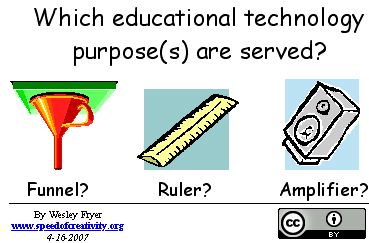I don't see any signs the proliferation of read/write web tools is going to slow down soon. There are many places to go to learn about new (and "older" / more mature) web 2.0 technologies. Karen Montgomery has a good list of sources, including S. Summerford's Filamentality hotlist "Web 2.0 for the Classroom Teacher" and "Go2Web2.0."
More than a comprehensive hotlist, however, I'm seeking frameworks for "cognitive maps" that can help me as well as other teachers better understand the FUNCTIONS, respective PURPOSES, and appropriate CONTEXTS for using read/write technologies for learning. Although there is obviously overlap, I'm wondering if most tools can be categorized into the following groups:
- Collaborative tools
- Research tools
- Digital storytelling tools
I've been reflecting even more generally, beyond just web 2.0 applications, on the ways we should be thinking about using educational technologies in the classroom. In striving to make more read/write learning opportunities available for students, I'm wondering if more school leaders should be asking how digital technologies can be used as AMPLIFIERS for learning, rather than as strictly FUNNELS or RULERS:

Andrew Churches has done some great work along these lines as well, tying in Bloom's taxonomy, and created the wiki "Educational Origami" in response to the post "Read/Write Tools Chart" by Miguel Guhlin. Andrew's framework and lists include desktop applications (mainly for Windows-based computers) as well as web-based tools, contrasting traditional versus digital approaches to teaching as well as how the 2001 revision to Bloom's taxonomy by Anderson and Krathwohl relates to digital teaching alternatives.
Which framework is best or will prevail? I won't claim to know, but I think each of these reflections can add to our own cognative map building of web 2.0 tools and appropriate uses. Our digital toolset will continue to morph and grow in the years ahead, while our need to understand appropriate uses for these protean tools will undoubtedly persist.